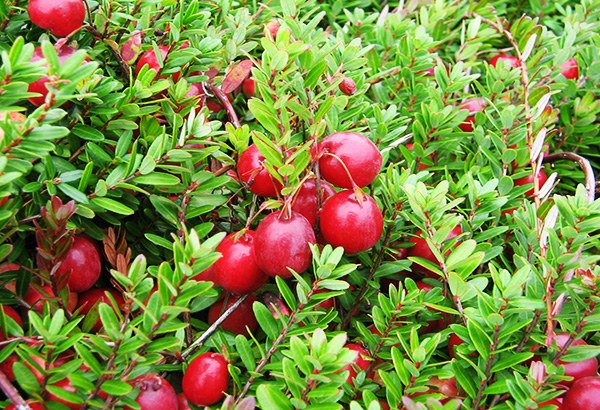Cranberries are a wild berry, which almost all villages used to gather in the old days. Even today, in the autumn, in deaf swampy places, there are often enthusiasts who carry whole backpacks of the sour Zharaviki. Such zeal is justified. Cranberry has a complex of useful substances for the body and is used not only in cooking, but also in traditional medicine.. Therefore, the cost of a jar of berries on the market reaches 1000 rubles. Details about where and how the cranberry grows, what time of ripening - in this material.
Table of contents
Cranberries - General Information and Varieties
This plant of the heather family can be found throughout the Northern Hemisphere. Cranberries belong to the Vaccinium genus and are accounted for by the close “relatives” of blueberries, blueberries and lingonberries.
There are four types of wild cranberries:
Ordinary

Evergreen shrub that grows in the northern and temperate latitudes of the Eurasian continent. Creeping shoots, long (up to 80 cm), thin, lignescent, brown in color. Flowering shoots raised, leaves - ovate, 5-10 mm long, petiolate, with an alternate arrangement. The color of the leaf plates on top is dark green, the bottom is gray, with a wax coating. It blooms in May and June with reddish-pink drooping flowers. Keeps up by September. The diameter of the fruit - to 16 mm.
Small-fruited
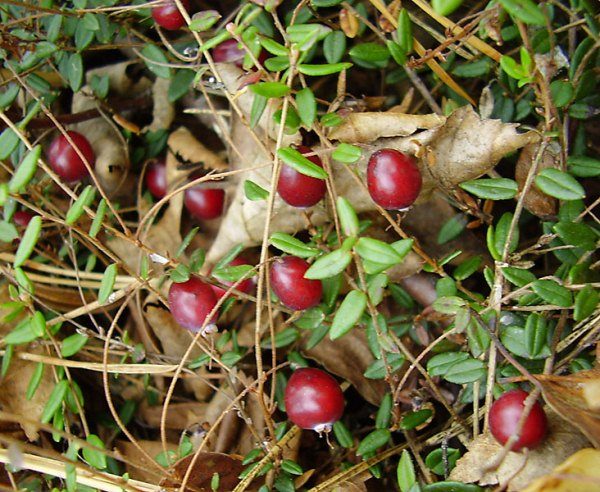
Another Eurasian species, the Pleistocene relict. Creeping shoots, filiform, about 30 cm long. The leaves are small, 3-6 mm, leathery, dark green on top. The bottom side of the sheet plate is gray. The flowers are small, pink. Fruits diameter 5-8 mmripen from late July to August. The species is listed in the Red Books of many regions of Russia (Voronezh, Lipetsk, Ryazan, etc.).
Large fruit
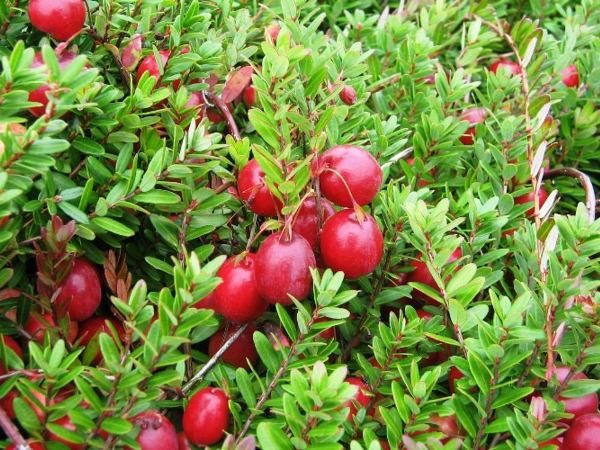
Widespread in Canada and the United States, where the northern boundary of its growth lies along the 51st parallel. The leaves of the shrub are oblong, in the fall they are burgundy, in the spring they restore a green color. Fruits are large - to 25 mm in diameter, carried on long shoots to a height of 30 cm. Starts to sing in mid-September. On the basis of the American wild-growing cranberries cultivated large-fruited varieties.
Red-fruited Vaccinium
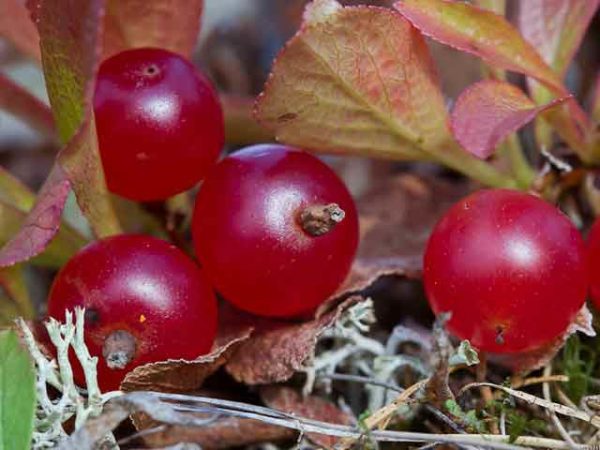
It has two subspecies. The first is distributed in North America in the South Appalachians. The second is in East Asia (China, Japan, Korea). Deciduous shrub that grows in the penumbra of mountain forests. Berries ripen in late August - mid September.
The Latin name for cranberries - Oxycoccus - means “sour ball”. She has a lot of folk names: spring bark, jaravika, zaravitsa, marsh grapes, bear berries, etc. In some places, cranberries are called "zhuravina". Most likely, this word reflects the similarity of the flowers of the plant with the head of a crane.
The fruits of all types of cranberries are valued for their high content of vitamin C and anthocyanins. It is an indispensable natural remedy for inflammatory urinary diseases.. Many scientists believe that cranberries should be included in the list of products required for cancer prevention.
How and where does cranberry grow?
The Delaware Indians had a legend, according to which cranberries grow in the places of battle of the ancient giants - where their blood was shed. In part, this makes sense. Cranberries are berries of peat, tundra and sphagnum bogs, and their age ranges from 12 thousand to 400 million years.
In Russia, cranberries grow in moist coniferous forests, marshy lowlands, on old peatlands. It is widespread in the European part of the country, in Karelia, on Kamchatka, Sakhalin, in Siberia. The northern boundary of its range is in the area of the Arctic Circle (forest-tundra zones). From the south, the area of cranberry growth is limited to the 62nd parallel and coincides with the boundaries of the distribution of wetlands.
For the normal development of cranberries require a lot of light and clean water.In ecologically unfavorable places, it grows poorly, therefore, there are no cranberry “palestines” near major cities. This berry is not demanding to the mineral composition of the soil.. The roots of the shrub form a symbiosis with soil fungi that help the plant to "get food". Soils cranberry chooses left, easily transferring the pH to 2.5.
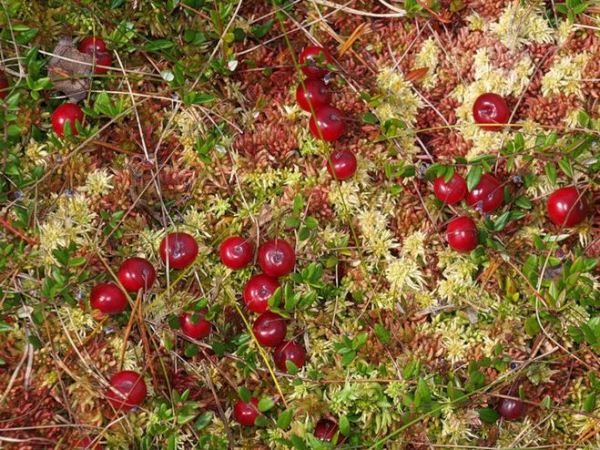
Cranberry bushes are able to form mats, spreading over moss and weaving together shoots. From one cranberry "Palestinian" to another can be quite a long distance. Sometimes it is necessary to walk several kilometers along springy moss and viscous mud.
When does the berry begin to ripen and the date of harvest in Russia?
Cranberries can be summer, autumn and spring collections. Most often, it begins to collect in the autumn - in September-October, before the frost. However, a distinctive feature of cranberry fruit is the ability to hibernate on the plant. Frost berry is not damaged, but only accumulates sugar. That is why many people prefer to pick cranberries not in autumn, but in spring.
The chemical composition in percent per 100 g of fruit is as follows:
| Dry matter | 11,75 |
|---|---|
| Water | 88,25 |
| Sugar | 2,84 |
| Lemon acid | 2,45 |
| Cellulose | 2,01 |
| Pectin | 0,73 |
| Nitrogenous substances | 0,32 |
| Ash | 0,22 |
The ratio of these elements varies depending on the growing conditions and the time of picking berries.
Cranberries summer harvest hard, white or not fully painted. Over time, it matures, but retains a lot of acid and does not gain the right amount of sugar. This berry is not tasty and juicy. Cranberries have less nutrients, more bitterness, and it is poorly stored.
When collecting pay attention to the color of the fruit. Experienced pickers prefer to take cranberries, which have acquired a dark purple hue. It is believed that in such a berry the concentration of biologically active substances is maximum.

Spring cranberries that wintered under the snow are much sweeter than autumn ones, but there is almost no vitamin C left in it. In the berries of the autumn harvest more pectinthat matters if the fruit is intended for processing or confectionery use. On the skin of autumn cranberries retain the activity of microorganisms responsible for the fermentation processes. Therefore, this berry is better suited for winemaking.
Because of the reduced percentage of acid, spring snow cranberries are worse stored. The transportability of the autumn harvest is also better.
How to pick cranberries?
In industrial cultivation, cranberry harvesting is more often mechanized. Plantations are arranged in special peat pits-clusters. When it is time to gather, water is pumped into the clusters through pipes, and the plantation is flooded to a depth of about half a meter..
The cranberries are lightweight, therefore they float to the surface. Then, a caterpillar harvester equipped with combs in front and behind is released to the plantation. The machine breaks berries, which can only be collected networks.
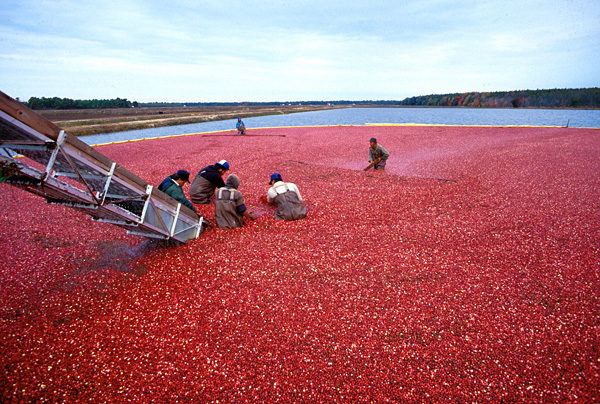
But hand picking cranberries - hard physical labor. After many hours of walking through the swamp with mosquitoes and gadflies, the collector has to squat for a long time, pushing off the plexuses of the shoots and tearing off the berries one by one. Therefore, many are trying to facilitate the process with the help of special tools.
Now on sale you can find many models of combines-fruit collectors for berries.Some craftsmen independently make scoops, comb, allowing you to quickly "comb" cranberry glades. but In many regions, the legislation of the Russian Federation places restrictions on this method of collecting. The fact is that the “chees” can severely injure the plants, cutting off the leaves and shoots. Therefore, going for cranberries, you need to familiarize yourself with the local collection rules.
Conclusion
In the middle of September an annual festival is held in the Tver region - the cranberry festival, timed to the beginning of the picking season of this berry. In Arkhangelsk, a similar event is held a little later - in early October. At the same time, cranberries are honored in the western hemisphere - in Canada, where on the berry plantations they are allowed to be photographed in the “cranberry sea” prepared for harvesting.
Wild cranberries are a berry of exceptional value, but not everyone can pick them in the swamp.. And then the independent cultivation of this plant on the site becomes a good way out. Breeding method created a considerable number of large-fruited cultivars.With some effort and creating the necessary conditions for the plants, in just three or four years you can get your own cranberry "Palestinian".
